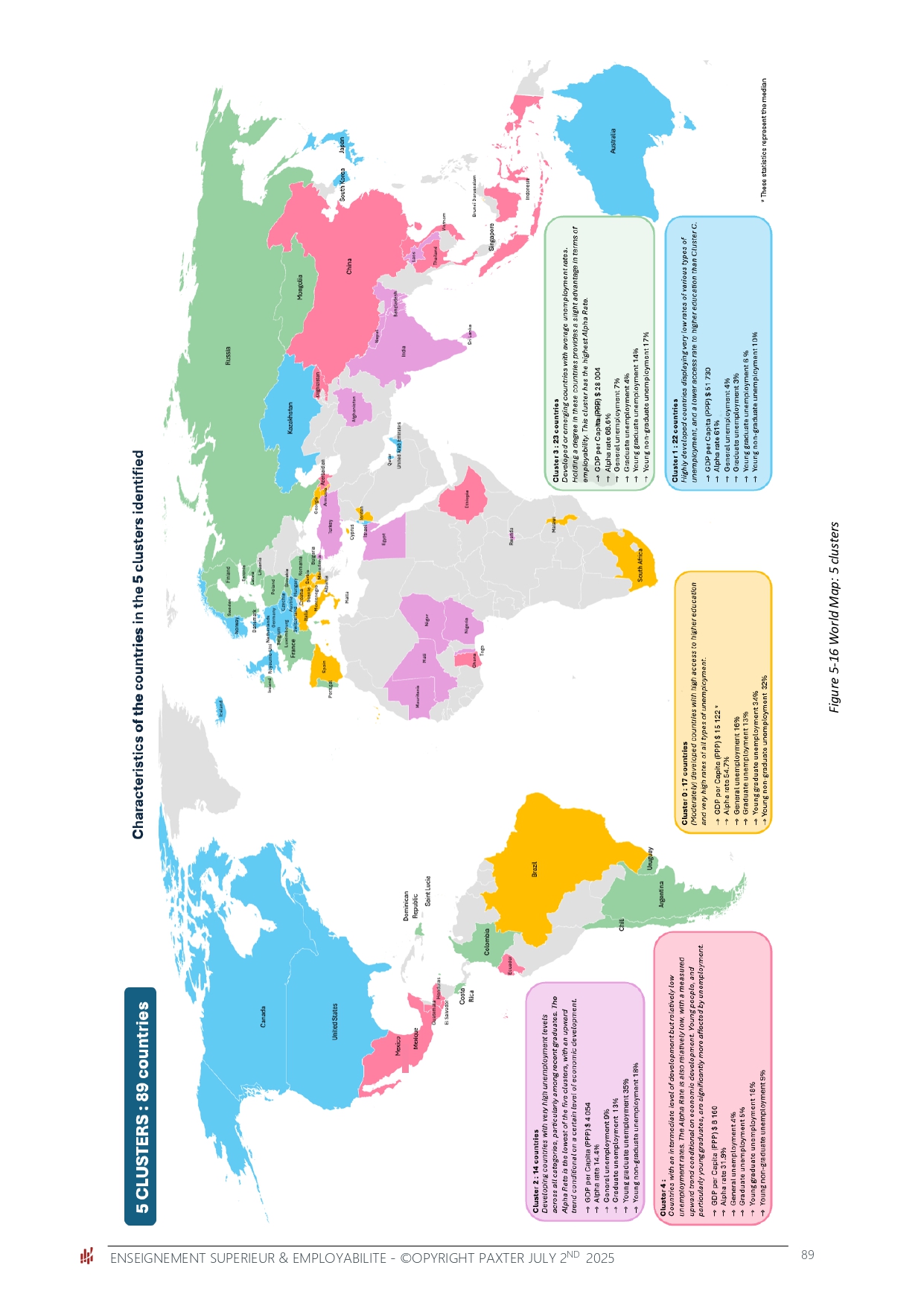Front-page news
Demographics & statistics
15 mn
Synthesis of the study “Higher Education, Revenue & Employability: A global comparative study” by Paxter

By Laetitia Aroichane
On July 2, 2025, the academic strategy and educational engineering consulting firm Paxter published the results of a global study on the links between economic development, access to higher education, and employability. Unprecedented in its scope, this research—conducted by Pierre Aliphat, Nikola Damjanovic, and Pierre Tapie—is based on a sample of 140 countries. It cross-references several variables : GDP per capita in purchasing power parity (GDP/Capita (PPP)), higher education access rates, and six types of unemployment rates (general, graduate, non-graduate, youth, young graduate, and young non-graduate).
The study’s innovative dimension lies primarily in the density of data processed, covering countries representing more than 90% of the world’s population and youth, with higher education access rates studied individually for each country. The findings suggest that beyond the level of education, it is indeed the relevance of qualifications for employment and for the stage of economic development that determines individuals' employability.
A research structured by five successive questions
Question 1 : What is the relationship between a country’s level of economic development and access to higher education ?
A strong correlation (R = 0.72) is observed between GDP/Capita (PPP) and access to higher education. After removing outlier countries (oil producers or financial hubs), this correlation reaches R = 0.84. It is particularly marked in low-income countries (GDP/Capita < $15,000), with R = 0.78. However, beyond this threshold, the correlation disappears, indicating that in high-income countries, economic development and higher education access become independent.
Question 2 : Can correlations be established between economic development and different unemployment rates (general, graduates, youth, and young graduates) ?
Correlations between GDP/Capita (PPP) and general unemployment, youth unemployment, and young non-graduate unemployment are weak (ranging from -0.22 to -0.25). The non-graduate unemployment rate shows no correlation with economic development. However, negative correlations are found with graduate unemployment (R = -0.612) and young graduate unemployment (R = -0.641): in emerging countries, a more educated workforce is required to develop further.
Question 3 : What are the relationships between access to higher education and employability? Does this depend on the level of economic development ?
- Access to higher education does not influence general unemployment, youth unemployment, non-graduate unemployment, or young non-graduate unemployment.
- Moderate negative correlations are observed with graduate unemployment (-0.38) and young graduate unemployment (-0.46), explaining 14% and 21% of their variations, respectively.
- In 55 out of 88 countries, holding a degree improves employability; in 33, it hinders it, often in countries with GDP/Capita < $15,000.
- In some countries, having a degree is a disadvantage for adult female graduates, though not for young female graduates.
Question 4 : Can countries with similar wealth and employability characteristics be grouped into homogeneous categories (1) ?
The study identifies five country clusters with similar dynamics (see map below) :
- Cluster A : Developing countries with high unemployment and low access to higher education. The only significant correlation is between higher education access and GDP/Capita (PPP) (0.829). Examples include Afghanistan, Bangladesh, Egypt, India, Laos, Mali, etc.
- Cluster B : Middle-income countries with moderate unemployment. Access to higher education remains relatively low but shows a clear upward trend driven by economic development. The only significant correlation is between higher education access and GDP/Capita (PPP) (0.621). Examples include Azerbaijan, China, El Salvador, Ethiopia, Ecuador, etc.
- Cluster C : Middle-income countries with a high level of graduates but high unemployment in all categories, especially among youth (35%). The only significant correlation is between higher education access and young graduate unemployment (-0.571). Examples include South Africa, Albania, Armenia, Brazil, Spain, Italy, etc.
- Cluster D : Developed countries with high non-graduate unemployment. In these countries, graduate unemployment is lower than non-graduate unemployment. This cluster has the highest access to higher education. Significant correlations are observed between higher education access and non-graduate unemployment (0.434), and between access and young graduate unemployment (-0.528). Examples include France, Argentina, Belgium, Ireland, Portugal, Russia, etc.
- Cluster E : Wealthy countries with low unemployment and no significant correlations. Access to higher education is significantly lower than in Cluster D, even though the average GDP/Capita (PPP) is nearly double. Examples include Germany, Australia, UAE, United States, Japan, Singapore, etc.
Overall, in wealthy countries, increased access to higher education raises unemployment among non-graduates (relative downgrading) but has no effect on graduate unemployment.
The employability of different populations—measured by six types of unemployment rates—appears to be a persistent reality within each cluster over long or very long periods. These are the durable outcomes of socio-economic conditions that characterize the various clusters and countries. These international comparisons show that youth employability depends on the ability to employ all qualification levels, from the least to the most educated. It also depends on countries’ ability to adapt the level and type of qualifications of their workforce to their economies’ needs.
Question 5 : In cases where significant correlations exist, particularly between higher education access and young graduate unemployment, what is the strength of these correlations, and can predictive models be built ?
Two models were tested :
- Multiple linear regression: R² = 62%. A 1% increase in higher education access in 2013 reduces young graduate unemployment in 2017 by 0.3%.
- Ensemble model: R² = 87%. In countries where access rates are < 50%, increases in access significantly reduce young graduate unemployment three years later. Beyond 50%, the effect disappears.
Conclusion
The study thus shows that economic development and access to higher education are linked in countries with GDP/Capita (PPP) below $15,000, but become independent beyond that. In wealthy countries, increasing access to higher education - especially generalist programs - does not guarantee improved employment outcomes. The proportion of young people in employment does not rise with increased access.
However, in developed countries where youth and non-graduate insertion is difficult - such as France - expanding access to higher education does not increase graduate employability and reduces that of non-graduates, with a slight increase affecting general unemployment, likely due to the diploma's "signaling effect."
Moreover, in countries where higher education access already exceeds 50%, further increases have no effect on young graduate unemployment four years later. This is not due to cluster-related bias: employability characteristics remain stable over time and reflect durable socio-economic structures.
"The key challenge in wealthy countries is the employability of those with low qualifications".
Pierre Tapie, co-founder of Paxter
Characteristics of the countries in the 5 clusters identified

Note
(1) Clustering is a statistical analysis method used to organize raw data into homogeneous groups. Within each cluster, data points are grouped based on a shared characteristic. The ordering tool is an algorithm that measures the proximity between each element based on predefined criteria.
Read the full study
- In full in English
- In full in French
By Laetitia Aroichane
All topics
- France: future, opportunities & strategy
- Cost & financing
- Demographics & statistics
- Qualifications & accreditations
- Higher education institutions & Territories
- Equality
- Teaching, Pedagogy & Digital technology
- Environment & CSR
- Lifelong education and training
- Laws & Regulations
- Labour market, Professionalisation & Entrepreneurship
- International mobility & Attractiveness
- Higher education worldwide
- Research & Innovation
- Secondary education & Access to higher education

